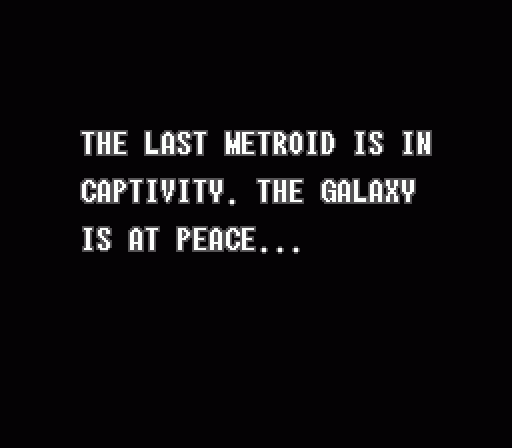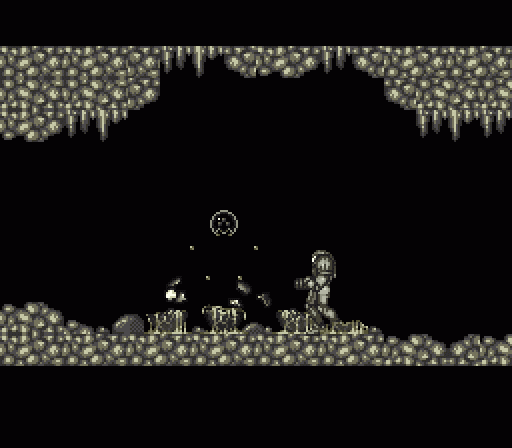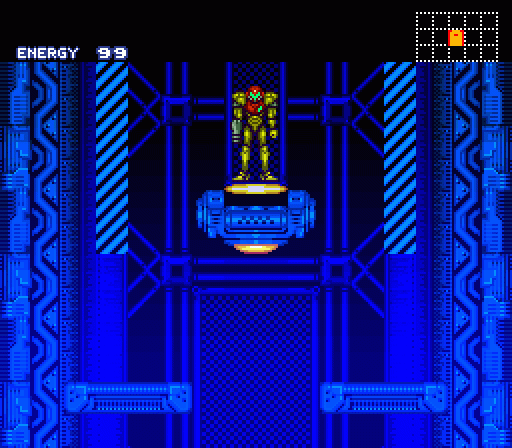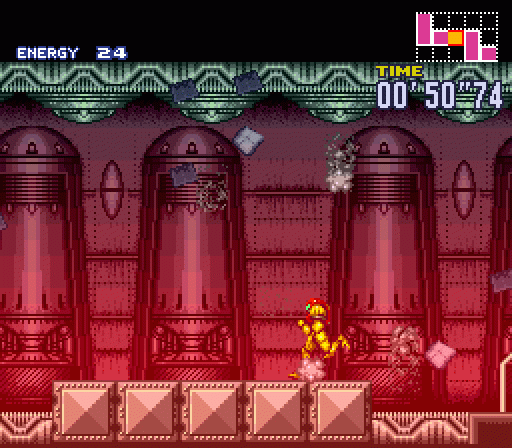Sometimes it seems a little hard to believe that Nintendo created Super Metroid. It’s such an un-Nintendo-like game — so somber and moody, so straight-faced, so rich with narrative innovation that feels nothing at all like what we’ve come to expect from Nintendo. And yet, it’s quintessentially classic Nintendo in many ways: It leads you along with unspoken hints, gives you many tools without over-complicating things, rewards you both for being focused and for being curious, and like A Link to the Past represents such a perfect expression of a game concept that no one has managed to truly best it without building on its foundation.
Super Metroid represents not only a maturing of the Metroid franchise, but of game design and technology as well. It married top-notch visuals to highly refined gameplay; in fact, it was the biggest game Nintendo had ever created to that point, weighing in at 24Mb. The perfect marriage of quality and quantity.
Unusually for a Nintendo game, Super Metroid commits to telling a story from start to finish. Unlike their other action games, the plot isn’t simply an excuse to kick things off; the tale unfolds throughout the adventure. Unlike non-Nintendo action games of the time, however, you never have to deal with non-interactive cut scenes breaking up the action. Once the introductory dialogue ends, you don’t have to read a single scrap of dialogue until the finale; and yet, its conclusion is one of the most gripping and memorable story moments in gaming. With Super Metroid, Nintendo R&D1 mastered the art of subtlety, and the more closely you pay attention the more you get from the game.
In this series, I’ll obviously be focusing on how Super Metroid‘s game design unfolds and guides you through its non-linear world, but I’ll also be taking the time to make note of how its story unfolds through action and environmental cues. The Anatomy of a Game started off talking about how Castlevania relayed a progressive narrative through its stage design, but Super Metroid elevates this from a neat extra detail to an essential motif.

Super Metroid begins telling its story before you even begin playing. The title screen provides a very cinematic opening, panning across disjointed scenes from a darkened laboratory where bodies lay dead on the floor before pulling back to reveal a metroid larva at the center of the chaos, chittering away to itself. It’s an intriguing introduction, even if you don’t know the series at all. What is this creature, and how could it have caused these deaths while sealed away inside a double-walled capsule? Or is something else at work here?
This scene does more than simply set up the premise, though. The sounds you hear here are important to the plot, and by integrating them into the title screen the game’s creators ensure you’re given a reminder of what the baby metroid sounds like every time you play. If you skip past the opening pans, the game immediately leaps to the title screen. You won’t think anything of the sound effects, but by making those chirps a part of the process of jumping into the game, Super Metroid guarantees that when they become relevant again, hours down the road, you’ll immediately understand the nature of what has transpired without the need to explain it with immersion-breaking dialogue.



Once you begin the game proper, you’re treated to a narrative flashback. The last metroid is in captivity, and here’s how we got to this point. Narration overlaid atop heroine Samus Aran’s visor alternates with monochrome images of the climactic scenes of Metroid and Metroid II. Like the title screen, these moments serve a dual purpose: Not only do they bring new players up to speed on the plot, they also redraw those 8-bit adventures in Super Metroid style to make the in-game references to those moment recognizable. When these flashbacks become relevant, you’ll have the context necessary to understand the references thanks to this introduction.

The introduction culminates in an image that ties it all to the title screen: The double-walled tube surrounded by scientists, though here they’re alive. Back to Samus discussing how she handed over the metroid larva to the scientists, who discovered the species’ previously unknown capacity for creating energy, not just absorbing it — another important plot point — when the music cuts out dramatically. No sooner had Samus left the station than it came under attack.

And so begins the game as Samus returns to Space Colony Ceres to investigate the attack.
The place is entirely quiet save for the background hum of machinery. There are no visible threats in sight, and the station seems to be operating peacefully. In a nice touch, the doors open automatically; unlike the doors from the first two games, which you had to shoot open, here you simply walk up to them to make them open. It helps distinguish peaceful Ceres Station from the conflict zones of the previous games.

A few rooms from the entrance, you’ll find the lab from the title screen and intro. As before, the corpses of scientists are strewn about the ground, but this time there’s a significant difference: The glass tube has been shattered, and the metroid larva is nowhere to be seen.

Instead, you’ll find the metroid’s capsule in a small room nearby, sitting alone and untended in the darkness, chittering away as usual. Samus can’t pick it up, though, and when you turn to leave the room you find the door has locked behind you. Then you see a pair of eyes glowing in the dark, which quickly resolves (in a sort of reverse Cheshire Cat move) into a barely recognizable rendition of Ridley from the original Metroid, who immediately attacks.

This, of course, is a danger-free demo battle. You can’t lose here, because Ridley flies off as soon as he reduces you to critical health. (Inexplicably, Samus seems not to have learned the lessons of Metroid II and begins this adventure without either the Maru Mari or any missiles.) It’s a chance for you to get a handle on Super Metroid‘s combat, learning to evade Ridley’s attacks and while getting the hang of Samus’ new ability to shoot at a 45-degree angle. But even if you totally biff it, you’ll be just fine.
On the other hand, if you’re really awesome, you can actually do enough damage to Ridley that he’ll drop the capsule and take off to protect his own hide rather than waiting until he’s whittled Samus’ health down to critical.

Ridley takes the metroid with him, setting the plot into motion.
Metroid II ended without the trademark Metroid escape sequence, so R&D1 makes up for it here by beginning Super Metroid with one. You’re given a minute to escape Ceres, retracing your footsteps to the beginning, and if you fail to make it the place goes up with you inside for a nonstandard game over.
You do have to wonder what sort of jerk builds a self-destruct into a civilian space colony, though.

This sequence is far easier than the one at Metroid‘s end. You’ve already been through this route, and it’s pretty short. However, the game does throw in some new wrinkles. Where the Metroid escape scene was entirely based in a tall vertical shaft, the run through Ceres largely happens along horizontal corridors. To add a little difficulty to these portions, you have to contend with ceramic tiles falling loose as the station begins to shake itself to death. A tile won’t hurt Samus if it hits her, but it will stop her forward momentum and cost you a precious split-second.

The ascent up the vertical shaft at the entrance to the station is much easier than the one in Metroid was — your footholds are considerably wider, and the shaft is far shorter — but technology is your enemy here. The power of Mode 7 causes the screen to pitch left and right, forcing you to angle your jumps around constantly shifting platforms. This is no real challenge for Samus, who can steer her leaps in mid-air, and it’s a great opportunity to become acquainted with that particular quirk of her repertoire.
As the screen rotates, the platforms also bellow steam in short, timed bursts. Like the tiles of the adjacent corridor, the steam won’t hurt Samus, but it will halt her momentum. In this case, though, that represents more of a threat: If you lose your momentum in mid-air, you’ll fall to the platform below — or, if the pitch of the shaft isn’t tilted in your favor at the moment, even further.
You can deal with this easily enough; the bursts of steam fire off at regular intervals. It’s not hard to gauge and predict their timing. But if you try to simply rush through the shaft at top speed and escape right away, Samus will have a rough time of things. The first lesson to players appears here: Super Metroid is a game of precision and patience, not bull-headed action. With the help of your steady hand, Samus can reach the top of the entry tube and escape Ceres safely before it explodes.
Firstly, Yes Super Metroid! Secondly, this opening scene is still my favorite from any game I’ve ever played. It, along with the sequence in the dead pirate base prior to it coming back online, has more atmosphere and informs the player about the universe they are about to embark into than any other game before or after in my opinion.
Yay! Supa Metro! This game has one of the best beginnings ever.
It’s unfortunate that when I played Super Metroid, I hadn’t really played Metroid 1 (only Metroid 2), so I didn’t know that the beginning had you going through the remains of the last rooms of Metroid 1.
I imagine it should have been a powerful feeling to someone that played both Metroids before playing this one.
But at least I had played Metroid 2, so the scenes leading to the last battle made perfect sense to me.
Awesome. Definitely looking forward to this one. And sort of a fitting followup to yesterday’s Close Encounters article - Super Metroid applied its own subtle approach to storytelling. I also appreciate how SM informs the player on how to use new items - they make it fun in the opportunities they present, especially with the dash boots.
Super Metroid! So wonderful. This is going to be the silver tuna of Anatomies, I predict.
Inspired by the appreciative paeans I’ve been hearing for years from Jeremy and the like, I actually wrote about this game’s finale on my (normally not video game-related) web site earlier this year: http://gradingfightscenes.com/2013/04/28/super-metroid/
Fun fact: internally, the Samus that appears during the “flashbacks” is the same Samus you control once the game passes control back to you. If you cheat (say, by using the famous reset glitch), she’ll be decked out in the Gravity Suit even in “the past.” To make Samus fire the missiles in the flashback, the game gives her missiles and then promptly removes them. As a result, if you did use the reset glitch, you’ll find all your missiles gone after you go through this sequence!
The baby metroid chirps sound exactly like a bird I’ve heard in Florida. I wish I’d learned its name.
Happy to see another one so soon!
So can I go ahead and pre-order the Anatomy of Metroid book now? If not, I can always offer you my first born.
I really wonder how long you have been looking forward to this one? I know I am looking forward to reading it!
Yeah, this installment in the series is going to be Super interesting. Looking forward to the rest.
I guess that I am going to have to replay this game for the second time this year. Thankfully it shouldn’t be much of an issue since I have already replayed Metroid Fusion a half dozen times this year.
I fell like the anatomy series has been working towards this moment. Can’t wait to read more!
“You do have to wonder what sort of jerk builds a
self-destruct into a civilian space colony, though.”
I assume the kind who knew they intended to experiment on the most dangerous creatures in the universe.
Think Andromeda Strain.
Wow, didn’t expect to get Super Metroid here so soon. Not that I’m complaining about it.
On the subject of the game itself I get chills everytime that opening plays. Everything about it is so good and sets the tone for the rest of the game perfectly. It also doesn’t overstay its welcome, which is a lesson a lot of other games could stand to learn.
A curious note about the intro of Super Metroid is that the spoken line by Samus, (that surely took a good chunk of the allotted 24 megs), wasn´t done by a woman, but by Nintendo´s translator extraordinaire, Dan Owsen! http://metroid.wikia.com/wiki/Dan_Owsen He also did the voices for the original Starfox, so it seems he was a really talented voice actor too.
It struck me recently that the title Super Metroid is more than just “Metroid” with the obligatory SNES prefix added to it. The super metroid is right there, on the title screen! The little larva does indeed become a unique and superior metroid, and is an important plot device. I wonder if R&D1 had this in mind.
I assume they did. Certainly that’s always been my assumption!